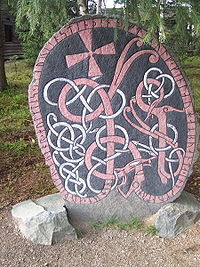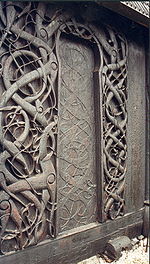
Urnes style
Encyclopedia




Scandinavia
Scandinavia is a cultural, historical and ethno-linguistic region in northern Europe that includes the three kingdoms of Denmark, Norway and Sweden, characterized by their common ethno-cultural heritage and language. Modern Norway and Sweden proper are situated on the Scandinavian Peninsula,...
n animal art
Animal style
Animal style art is characterized by its emphasis on animal and bird motifs, and the term describes an approach to decoration which existed from China to Northern Europe in the early Iron Age, and the barbarian art of the Migration Period...
during the second half of the 11th century and in the early 12th century. The preceding phases of Scandinavia's Viking Age
Viking Age
Viking Age is the term for the period in European history, especially Northern European and Scandinavian history, spanning the late 8th to 11th centuries. Scandinavian Vikings explored Europe by its oceans and rivers through trade and warfare. The Vikings also reached Iceland, Greenland,...
animal ornamentation are usually categorized as Oseberg style
Oseberg style
The Oseberg style is a Viking Era animal ornamentation in Norse art. -History:Oseberg style is named after the Oseberg ship grave, a well-preserved Viking age ship discovered in a large burial mound at the Oseberg farm near Tønsberg in Vestfold County, Norway...
, Borre style
Borre style
Borre style is a Viking Era animal ornamentation which was first named after artifacts from a boat grave in Borre mound cemetery near the village of Borre, in Horten municipality, Vestfold county, Norway.-History:...
, Jelling style
Jelling style
The Jelling style is a phase of Scandinavian animal art during the 10th century. The style is characterized by markedly stylized and often band-shaped bodies of animals...
, Mammen style
Mammen style
The Mammen style is a phase of Scandinavian animal art during the late 10th century and the early 11th century. The style is named after finds from a chamber tomb in Mammen on Jutland, Denmark. The finds included a silver engraved axe of which one side shows a markedly stylized animal with long...
and Ringerike style
Ringerike style
The Ringerike style is a Scandinavian animal style from the late 10th century and the 11th century, which evolved out of the earlier Mammen style. It has received its name from a group of runestones with animal and plant motifs in the Ringerike district north of Oslo. The most common motifs are...
.
The Urnes style is named after the northern gate of the Urnes stave church
Urnes stave church
Urnes Stave Church is a stave church at the Ornes farm, along the Lustrafjord in the municipality of Luster in Sogn og Fjordane county, Norway, about east of the village of Hafslo....
in Norway
Norway
Norway , officially the Kingdom of Norway, is a Nordic unitary constitutional monarchy whose territory comprises the western portion of the Scandinavian Peninsula, Jan Mayen, and the Arctic archipelago of Svalbard and Bouvet Island. Norway has a total area of and a population of about 4.9 million...
, but most objects in the style are runestones in Uppland
Uppland
Uppland is a historical province or landskap on the eastern coast of Sweden, just north of Stockholm, the capital. It borders Södermanland, Västmanland and Gästrikland. It is also bounded by lake Mälaren and the Baltic sea...
, Sweden
Sweden
Sweden , officially the Kingdom of Sweden , is a Nordic country on the Scandinavian Peninsula in Northern Europe. Sweden borders with Norway and Finland and is connected to Denmark by a bridge-tunnel across the Öresund....
, which is why some scholars prefer to call it the Runestone style
Runestone styles
The runestone styles varied during the Viking Age. The early runestones were simple in design, but towards the end of the runestone era they became increasingly complex and made by travelling runemasters such as Öpir and Visäte....
.
The style is characterized by slim and stylized animals that are interwoven into tight patterns. The animals heads are seen in profile, they have slender almond-shaped eyes and there are upwardly curled appendages on the noses and the necks.
Early Urnes style
The early style has received a dating which is mainly based on runestone U 343, runestone U 344 and a silver bowl from c. 1050, which was found at Lilla Valla. The early version of this style on runestones comprises England RunestonesEngland Runestones
The England runestones is a group of about 30 runestones that refer to Viking Age voyages to England. They constitute one of the largest groups of runestones that mention voyages to other countries, and they are comparable in number only to the approximately 30 Greece Runestones and the 26 Ingvar...
referring to the Danegeld
Danegeld
The Danegeld was a tax raised to pay tribute to the Viking raiders to save a land from being ravaged. It was called the geld or gafol in eleventh-century sources; the term Danegeld did not appear until the early twelfth century...
and Canute the Great
Canute the Great
Cnut the Great , also known as Canute, was a king of Denmark, England, Norway and parts of Sweden. Though after the death of his heirs within a decade of his own and the Norman conquest of England in 1066, his legacy was largely lost to history, historian Norman F...
and works by Åsmund Kåresson
Åsmund Kåresson
Åsmund Kåresson was a Viking Age runemaster who flourished during the first half of the 11th century in Uppland and Gästrikland, Sweden. The early Urnes style is represented in his art.-Work:...
.
Mid-Urnes style
The mid-Urnes style has received a relatively firm dating based on its appearance on coins issued by Harald Hardrada (1047–1066) and by Olav KyrreOlaf III of Norway
Olaf Kyrre , or Olaf III Haraldsson, was King of Norway from 1067 to 1093. He was present at the Battle of Stamford Bridge in England in 1066 where his father, Harald Hardrada, saw defeat and was killed in action...
(1080–1090). Two wood carvings from Oslo
Oslo
Oslo is a municipality, as well as the capital and most populous city in Norway. As a municipality , it was established on 1 January 1838. Founded around 1048 by King Harald III of Norway, the city was largely destroyed by fire in 1624. The city was moved under the reign of Denmark–Norway's King...
have been dated to c. 1050-1100 and the Hørning plank is dated by dendrochronology
Dendrochronology
Dendrochronology or tree-ring dating is the scientific method of dating based on the analysis of patterns of tree-rings. Dendrochronology can date the time at which tree rings were formed, in many types of wood, to the exact calendar year...
to c. 1060-1070. There is, however, evidence suggesting that the mid-Urnes style was developed before 1050 in the manner it is represented by the runemaster
Runemaster
A runemaster or runecarver is a specialist in making runestones.Most early medieval Scandinavians were probably literate in runes, and most people probably carved messages on pieces of bone and wood. However, it was difficult to make runestones, and in order to master it one also needed to be a...
s Fot
Fot
Fot was a runemaster who flourished in mid-11th century Sweden.-Career:Most early medieval Scandinavians were probably literate in runes, and most people probably carved messages on pieces of bone and wood. However, it was difficult to make runestones, and in order to master it one also needed to...
and Balli
Balle (runemaster)
Balle or Red-Balle was a runemaster who was active in the areas of western Uppland, Västmanland, and northern Södermanland of Sweden during the second half of the 11th century.-Work:...
.
Late Urnes style
The mid-Urnes style would stay popular side-by-side with the late Urnes style of the runemasterRunemaster
A runemaster or runecarver is a specialist in making runestones.Most early medieval Scandinavians were probably literate in runes, and most people probably carved messages on pieces of bone and wood. However, it was difficult to make runestones, and in order to master it one also needed to be a...
Öpir
Öpir
Öpir or Öper was a runemaster who flourished during the late 11th century and early 12th century in Uppland, Sweden...
. He is famous for a style in which the animals are extremely thin and make circular patterns in open compositions. This style was not unique to Öpir and Sweden, but it also appears on a plank from Bølstad and on a chair from Trondheim
Trondheim
Trondheim , historically, Nidaros and Trondhjem, is a city and municipality in Sør-Trøndelag county, Norway. With a population of 173,486, it is the third most populous municipality and city in the country, although the fourth largest metropolitan area. It is the administrative centre of...
, Norway
Norway
Norway , officially the Kingdom of Norway, is a Nordic unitary constitutional monarchy whose territory comprises the western portion of the Scandinavian Peninsula, Jan Mayen, and the Arctic archipelago of Svalbard and Bouvet Island. Norway has a total area of and a population of about 4.9 million...
.
The Jarlabanke Runestones
Jarlabanke Runestones
The Jarlabanke Runestones is the name of c. 20 runestones written in Old Norse with the Younger Futhark in 11th century, Uppland, Sweden.They were ordered in the by what appears to have been a chieftain named Jarlabanke Ingefastsson and his clan , in Täby...
show traits both from this late style and from the mid-Urnes style of Fot and Balli, and it was the Fot-Balli type that would mix with the Romanesque style
Romanesque art
Romanesque art refers to the art of Western Europe from approximately 1000 AD to the rise of the Gothic style in the 13th century, or later, depending on region. The preceding period is increasingly known as the Pre-Romanesque...
in the 12th century.
Urnes-Romanesque style
The Urnes-Romanesque style does not appear on runestones which suggests that the tradition of making runestones had died out when the mixed style made its appearance since it is well-represented in GotlandGotland
Gotland is a county, province, municipality and diocese of Sweden; it is Sweden's largest island and the largest island in the Baltic Sea. At 3,140 square kilometers in area, the region makes up less than one percent of Sweden's total land area...
and on the Swedish mainland. The Urnes-Romanesque style can be dated independently of style thanks to representations from Oslo
Oslo
Oslo is a municipality, as well as the capital and most populous city in Norway. As a municipality , it was established on 1 January 1838. Founded around 1048 by King Harald III of Norway, the city was largely destroyed by fire in 1624. The city was moved under the reign of Denmark–Norway's King...
in the period 1100-1175, dendrochronological dating of the Lisbjerg frontal in Denmark
Denmark
Denmark is a Scandinavian country in Northern Europe. The countries of Denmark and Greenland, as well as the Faroe Islands, constitute the Kingdom of Denmark . It is the southernmost of the Nordic countries, southwest of Sweden and south of Norway, and bordered to the south by Germany. Denmark...
to 1135, as well as Irish reliquaries that are dated to the second half of the 12th century.

